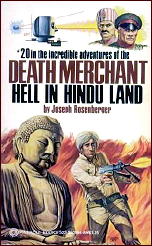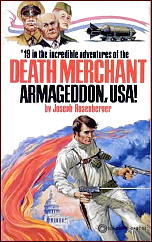Tue 18 May 2010
A 1001 MIDNIGHTS review: JOSEPH ROSENBERGER – Death Merchant #20: Hell in Hindu Land.
Posted by Steve under 1001 Midnights , Reviews1 Comment
by Bill Pronzini:
JOSEPH ROSENBERGER – Death Merchant #20: Hell in Hindu Land. Pinnacle, paperback original, 1976.

The remarkable success of Don Pendleton’s Executioner series (several million copies sold) naturally spawned the usual bunch of imitators, some of whom enjoyed no small success of their own. The most literate of these is Mike Barry’s Lone Wolf saga; the least literate (and funniest) is Joseph Rosenberger’s ongoing adventures of Richard Camellion (a.k.a. the Death Merchant).
Camellion is a sort of lunatic James Bond in that he is primarily occupied in eradicating threats to the free world arranged by Communist forces or members of a SMERSH-like organization called Spider. He, too, travels all over the world; the main difference between him and Bond is that 007 accomplishes his missions with wit and intelligence as well as violence, while the Death Merchant displays as much wit and intelligence as a “Goju-Ryu karate ball-of-the-foot koga geri groin kick,” which he uses whenever he is engaged in hand-to-hand (or hand-to-foot) combat.
Rosenberger takes the same jovial pleasure in describing breaking bones and teeth (spurting blood, too) as Camellion does in knocking off foreign “boobs.”
There are plenty of broken bones and teeth, and oceans of blood, in Hell in Hindu Land, number twenty in the series. It seems the CIA has been receiving reports that a mysterious secret room in a Buddhist monastery in India contains “secrets from the stars e.g., plans for a “bio-plasm” force that can defy gravity and a “psychotronic generator” that can harness the energy of the human mind — which were allegedly brought to earth by ancient astronauts from another planet.

Camellion is dispatched to India to check out this bizarre report and, if there is any truth in it, to gain control of the plans before his old KGB nemesis, Major Kondrashev, can claim them for Mother Russia. All of which is pure nonsense, of course — but no more so than Camellion’s antics on Indian soil, which are principally comprised of feverish battles with the Russians and/or the deadly tribesmen of Rajmahal.
What makes such as this worth reading (marginally so and in small doses) is Rosenberger’s inimitable style. (It has been said that he possesses unappreciated comic talents and that the Death Merchant series is not pastiche but parody; there is no evidence, however, to support such a claim.) The following representative snippet should serve as an indicator of whether or not you would like to become better acquainted with Rosenberger and Camellion:
“Drop the HK and pretend you’re trying to grab a couple of clouds from the sky, ” Camellion said lazily. “NOW!”
Surprise and confusion flickered over the faces of the other men. Dr. Panduhabaya looked as depressed as a sailor who had hoped for love but had been forced to settle for a pint of cheap booze and mechanical sex with a cheap slut.
Other titles in the series include The Albanian Connection (1973), The Mato Grosso Horror (1975), Armageddon, USA! (1976), and Blueprint Invisibility (1980).
———
Reprinted with permission from 1001 Midnights, edited by Bill Pronzini & Marcia Muller and published by The Battered Silicon Dispatch Box, 2007. Copyright © 1986, 2007 by the Pronzini-Muller Family Trust.
May 18th, 2010 at 6:33 pm
All I can say is that if Rosenberger was — as some have suggested — a genius in disguise, it was a damn good disguise.
But they are bad on a level that you may have to read to believe. The reaction isn’t just ‘This got published?’ so much as ‘So much of this got published?’ And ‘Someone is reading this for entertainment?’